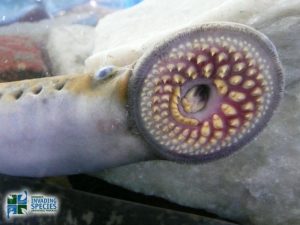They are all around us. Many humans interact with them on a daily basis. Even if you don’t have direct contact with them personally, all of us are impacted by their mere presence. They come in all shapes, sizes, and colors. Some of them are terrifying, others falsely appear harmless, and still others are so tiny they are invisible to the naked eye. I’m focusing on the ones that live in Lake Erie.

“Take me to your leader” (Photo by T. Lawrence, Great Lakes Fishery Commission)
That’s right ladies and gentlemen, I’m talking about aquatic invasive species (AIS). They go by many names: alien, introduced, exotic, non-indigenous, non-native. All of these descriptors just mean that it’s an organism that has been brought to a new environment where it doesn’t belong. If that new organism causes some harm, it is known as an invasive species. As in … it’s invading and taking over the new environment, causing harmful impacts on the aquatic natural resources and on the human use of these resources. Some of these species can cost communities millions of dollars due to pricey control efforts, damage to facilities and property, and negative impacts to local tourism opportunities.
According to the Great Lakes Aquatic Non-indigenous Species Information System, there are over 180 non-indigenous species reported to have reproducing populations in the Great Lakes basin, many of which are in Lake Erie. They’ve come from a variety of places and continue to spread, always with human help. Some major pathways include ballast water from international shipping vessels, aquarium introductions, intentional or accidental stocking, and barrier removal (such as shipping canals around Niagara Falls).

“If only controlling AIS in Lake Erie could be this much fun…” (Photo from www.gamefabrique.com)
So how can you help in the fight against these alien invaders?
- Learn to recognize AIS and report new sightings to the Ohio Division of Wildlife.
- Clean, Drain, Dry! When using boats or other aquatic recreational equipment, before leaving the water access: inspect and remove foreign material, drain water from all containers (bilge, livewell, etc.), clean with high pressure and/or heated water, and allow to dry for at least five days before transporting between bodies of water. Learn more at www.protectyourwaters.net.
- Dispose of unwanted bait, worms and fish parts in the trash
- Get Habitattitude! Never dump aquarium pets, plants, other organisms, or water, including bait, from one water body into another. Learn more at http://www.habitattitude.net/.

“We will not go quietly into the night! We will not vanish without a fight!” (Photo from www.IMDB.com)
For more information on AIS in the Great Lakes, check out the resources below or contact me at gabriel.78@osu.edu. And good luck to you as you join us in the fight to stop these alien invaders!
- Ohio Sea Grant
- GLANSIS
- Great Lakes Panel on Aquatic Nuisance Species
- Aquatic Nuisance Species Task Force
Tory Gabriel is the Extension Program Leader & Fisheries Outreach Coordinator (Ohio Sea Grant College Program).
Tory, great article. Just finished talking about this in Ecology last Semester. Thanks for the extra resources.
Thanks for the kind words Joe, and thanks for educating folks on the issue. Education is key to stopping the spread of AIS!